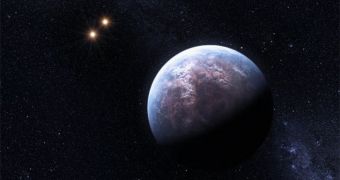Astronomers have discovered a large number of Jupiter-sized exoplanets inside the Milky Way, which were at first thought to be nothing more than space rocks. These celestial bodies, found orbiting their parent stars at various distances, can have Earth-like masses, but can also grow to be the size of a gas giant. Astrobiologists believe that some of the smaller ones, with masses two to ten times that of our planet, may actually be more suited for sustaining life than our corner of the solar system. Harvard University Astronomy Professor Dimitar Sasselov even coined a term for these exoplanets, and called them super-Earths, Space reports.
According to the professor, it may be that this type of planets is actually more likely to foster life than our own is. Maybe his idea does not make sense at first, but consider for a moment the rough history of the Earth. Since it first formed, more than 4.5 billion years ago, it took hundreds of millions of years to solidify, took such a huge slam that it created the Moon, and underwent a large number of Ice Ages and global-warming periods. Volcanic eruptions and tectonic activities killed off impressive numbers of life forms at times, and made the atmosphere unbreathable. On top of it all, there were five large extinction events over time, and it's estimated that 90 percent of all species that lived were wiped off.
Sasselov also says that the super-Earths would actually be more prone to experiencing a tectonic activity, such as earthquakes, mountain formation and eruption. He adds that these activity levels are tied directly to the mass of a planet, and to its size. In other words, a larger planet has a larger and hotter core, which is able to drive tectonic plates across the mantle faster, and cause more upheaval. In all likelihood, the mountains and valleys that would form would not endure for long, before the processes would again churn the thin crusts back into the mantle.
The expert adds that plate tectonics on Earth are made possible by the very fact that water exists. In fact, just enough of the stuff exists to allow for the process to take place. Super-Earths may either be completely covered in ice – a weird form known as iceVII – or lacking an ocean altogether. Their sheer sizes and masses make them especially suited for sustaining tectonics all on their own. Though it may seem dangerous, this process allows for carbon dioxide, a chemical essential for life, and the basis of the Earth's organisms, to be freed from the mantle and the crust, and released into the atmosphere.
Additionally, the exoplanets may be especially fit to keep an atmosphere in place. They would have much larger gravity forces than the Earth does, of up to 2 or 3 Gs. Humans can endure up to 5 Gs before losing consciousness, which means that space explorers could walk these planets in the distant future. They would do so with difficulty, but it is theoretically possible. The atmospheres around these planets would also extend less outwards, but would contain most of the chemical elements needed to foster life.

 14 DAY TRIAL //
14 DAY TRIAL //